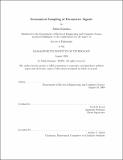| dc.contributor.advisor | Vivek K. Goyal. | en_US |
| dc.contributor.author | Kusuma, Julius | en_US |
| dc.contributor.other | Massachusetts Institute of Technology. Dept. of Electrical Engineering and Computer Science. | en_US |
| dc.date.accessioned | 2007-08-03T15:41:41Z | |
| dc.date.available | 2007-08-03T15:41:41Z | |
| dc.date.copyright | 2006 | en_US |
| dc.date.issued | 2006 | en_US |
| dc.identifier.uri | http://hdl.handle.net/1721.1/38225 | |
| dc.description | Thesis (Ph. D.)--Massachusetts Institute of Technology, Dept. of Electrical Engineering and Computer Science, 2006. | en_US |
| dc.description | Includes bibliographical references (p. 107-115). | en_US |
| dc.description.abstract | This thesis proposes architectures and algorithms for digital acquisition of parametric signals. It furthermore provides bounds for the performance of these systems in the presence of noise. Our simple acquisition circuitry and low sampling rate enable accurate parameter estimation to be achieved economically. In present practice, sampling and estimation are not integrated: the sampling device does not take advantage of the parametric model, and the estimation assumes that noise in the data is signal-independent additive white Gaussian noise. We focus on estimating the timing information in signals that are linear combinations of scales and shifts of a known pulse. This signal model is well-known in a variety of disciplines such as ultra-wideband signaling, neurobiology, etc. The signal is completely determined by the amplitudes and shifts of the summands. The delays determine a subspace that contains the signals, so estimating the shifts is equivalent to subspace estimation. By contrast, conventional sampling theory yields a least-squares approximation to a signal from a fixed shift-invariant subspace of possible reconstructions. Conventional acquisition takes samples at a rate higher than twice the signal bandwidth. | en_US |
| dc.description.abstract | (cont.) Although this may be feasible, there is a trade-off between power, accuracy, and speed. Under the signal model of interest, when the pulses are very narrow, the number of parameters per unit time-the rate of innovation-is much lower than the Fourier bandwidth. There is thus potential for much lower sampling rate so long as nonlinear reconstruction algorithms are used. We present a new sampling scheme that takes simultaneous samples at the outputs of multiple channels. This new scheme can be implemented with simple circuitry and has a successive approximation property that can be used to detect undermodeling. In many regimes our algorithms provide better timing accuracy and resolution than conventional systems. Our new analytical and algorithmic techniques are applied to previously proposed systems, and it is shown that all the systems considered have super-resolution properties. Finally, we consider the same parameter estimation problem when the sampling instances are perturbed by signal-independent timing noise. We give an iterative algorithm that achieves accurate timing estimation by exploiting knowledge of the pulse shape. | en_US |
| dc.description.statementofresponsibility | by Julius Kusuma. | en_US |
| dc.format.extent | 115 p. | en_US |
| dc.language.iso | eng | en_US |
| dc.publisher | Massachusetts Institute of Technology | en_US |
| dc.rights | M.I.T. theses are protected by copyright. They may be viewed from this source for any purpose, but reproduction or distribution in any format is prohibited without written permission. See provided URL for inquiries about permission. | en_US |
| dc.rights.uri | http://dspace.mit.edu/handle/1721.1/7582 | |
| dc.subject | Electrical Engineering and Computer Science. | en_US |
| dc.title | Economical sampling of parametric signals | en_US |
| dc.type | Thesis | en_US |
| dc.description.degree | Ph.D. | en_US |
| dc.contributor.department | Massachusetts Institute of Technology. Department of Electrical Engineering and Computer Science | |
| dc.identifier.oclc | 153965572 | en_US |

